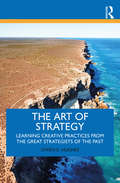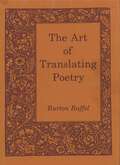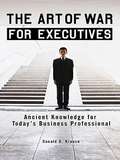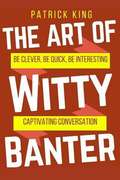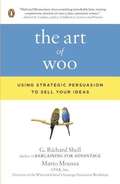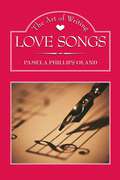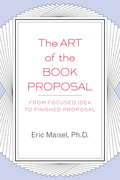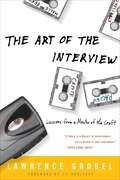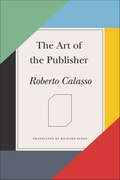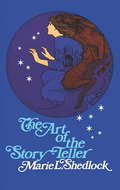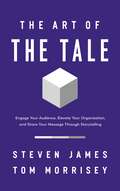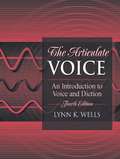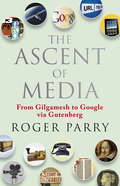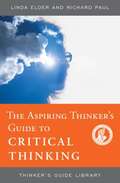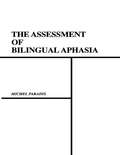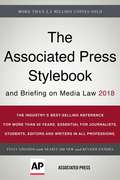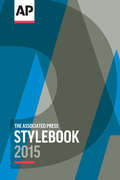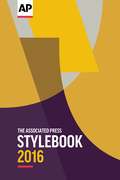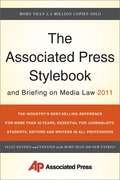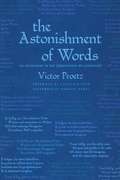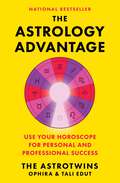- Table View
- List View
The Art of Strategy: Learning Creative Practices from the Great Strategists of the Past
by Owen E. HughesStrategy is best understood not as a science, but as an art – one of universal applications that transcend situation or historical context. The principles that were successful in war and politics through history can have real and demonstrable applications in business and management. Here, professor of strategy Owen Hughes helps practitioners and students to draw those parallels and to develop a profound and holistic understanding of strategy that will help them plan for, and achieve, success. Describing strategy as an intersection of five facets – purpose, capability, will, terrain and tactics – Hughes draws from colourful and dramatic examples from history, and clearly demonstrates how these tactics might be applied in your own life and work. This book is an ideal strategy text for any practitioner, lecturer or student who tires of familiar strategy frameworks with limited scope.
The Art of Translating Poetry
by Burton RaffelThis book by a well-known translator and critic is divided into two parts, the first dealing with the linguistic and other more technical aspects of translating poetry, the second involved with more practice-oriented matters. The chapters in Part One examine the specific constraints of language and the unavoidable linguistic bases of translation; the constraints of specific languages; forms and genres; and prosody and comparative prosody. Part Two looks at the subjective element in translation; collaborative translation; the translation of oral poetry; and the translator's responsibility.Languages discussed include Indonesian, Japanese, Chinese, Old and Middle English, French, German, Spanish, Italian, Persian, Russian, Latin, and Greek. The book argues, inter alia, that literal translation is impossible; that no translation can fully create the original but that good literary translation can create a usable approximation; that translation is secondary not only to the original work being translated but also to the linguistic (and literary) nature of the language being translated into; that the literary translator's primary responsibility is to the work he is translating; that there is nothing ever definitive about any translation; that the poetry translator must be a poet and poems should not be translated into prose; and that there must be a subjective identification between translator and translated work.This is the first attempt to systematize linguistic information about the translation of poetry. It is also the first book to range widely over the languages and literatures of the past and the present, and European and Asian languages and literatures as well. Raffel is the first author to combine in one study linguistic and scholarly knowledge and extensive experience of translation.
The Art of Translating Poetry
by Burton RaffelThis book by a well-known translator and critic is divided into two parts, the first dealing with the linguistic and other more technical aspects of translating poetry, the second involved with more practice-oriented matters. The chapters in Part One examine the specific constraints of language and the unavoidable linguistic bases of translation; the constraints of specific languages; forms and genres; and prosody and comparative prosody. Part Two looks at the subjective element in translation; collaborative translation; the translation of oral poetry; and the translator's responsibility.Languages discussed include Indonesian, Japanese, Chinese, Old and Middle English, French, German, Spanish, Italian, Persian, Russian, Latin, and Greek. The book argues, inter alia, that literal translation is impossible; that no translation can fully create the original but that good literary translation can create a usable approximation; that translation is secondary not only to the original work being translated but also to the linguistic (and literary) nature of the language being translated into; that the literary translator's primary responsibility is to the work he is translating; that there is nothing ever definitive about any translation; that the poetry translator must be a poet and poems should not be translated into prose; and that there must be a subjective identification between translator and translated work.This is the first attempt to systematize linguistic information about the translation of poetry. It is also the first book to range widely over the languages and literatures of the past and the present, and European and Asian languages and literatures as well. Raffel is the first author to combine in one study linguistic and scholarly knowledge and extensive experience of translation.
The Art of Video Production
by Dr Leonard C. ShylesThe Art of Video Production emphasizes the enduring principles and essential skills of the communication process and the new digital technologies that are necessary to create effective video content. Author Leonard C. Shyles uses a unique approach by explaining how things are done and why things are done rather than just that they are done—it is not about concepts versus skills, but about concepts and skills.
The Art of War for Executives
by Krause Donald G.The first book to provide a clear easy-to-follow interpretation of Sun Tzu's classic document. The Art of War for Executives shows how to win on the battlefield of business.
The Art of Witty Banter: Be Clever, Be Quick, Be Interesting - Create Captivating Conversation
by Patrick KingLearn conversational agility to think quickly on your feet, be incredibly smooth, funny, and clever – all at once. Goodbye awkward silences! No matter where you lie on the spectrum of awkward to engaging, witty banter is always the end goal – and it should be. Witty banter, and all the steps that lead to it, allows you to (1) disarm and connect with anyone, (2) immediately exit boring small talk mode, and (3) instantly build rapport like you’re old friends. Flow with the conversational twists and turns like water. The Art of Witty Banter is a book that carefully examines the art, nuance, and mechanics of banter and charm to make you witty comeback machine, the likes of which your friends have never seen. You’ll be able to handle, defend, disarm, and engage others in a way that makes you comfortable and confident with each growing day. Transform interview conversations to comfortable rapport. Patrick King is an internationally bestselling author and social skills and conversation coach. As someone who teaches people to speak for a living, he’s broken wit and banter down to a science and given you real guidelines on what to say and when. Make a sharp, smart, and savvy impression – every time. There’s no guesswork here – you’ll get exact examples and phrases to plug into your daily conversations. 18 specific points to up your charisma quotient. How will you be clever, be quick, and be interesting? •Why the questions you use make people freeze. •How to master teasing, witty comebacks, and initiating jokes and humor. •What free association is and how it makes you quick-witted. •How to create an instant “in-group” and inside joke with someone. As well as: •The reactions and exact phrases to make yourself be heard. •How to create your Conversation Resume. •The best types of compliments to give and what you’re doing wrong. •What a fallback story is and how it can save you. Conversation is the key to all that you want in life. Make the most out of them and specialize in witty banter. If you can roll with any punch, be quick and lively, and make it look effortless, what would that say about you? You’ll have a waiting list for your new friends! Make the best impression on your first try, and never be worried that you’re boring anyone again.
The Art of Woo
by G. Richard Shell Mario MoussaSelling ideas-especially the kinds of ideas that make organizations work-is a skill shrouded in mystery. In The Art of Woo, Professors G. Richard Shell and Mario Moussa offer a self-assessment to determine which persuasion role fits you best and discuss how to make the most of your natural strengths.
The Art of Writing Love Songs
by Pamela Phillips OlandFinally—the first songwriting guide to the most popular music genre in history! Written by a professional songwriter, The Art of Writing Love Songs provides inspiration to anyone seeking to write captivating songs about the most enduring musical subject of all. Readers will discover how to express their feelings in lyrics, master a wide scope of emotions and moods, choose an appropriate musical style, and craft beautiful songs that will woo any audience. This user-friendly guide presents technical information with precision, yet wrapped in a conversational, personal tone that&’s entertaining and easy to read. Packed with references to favorite hit songs, this must-have guide enables songwriters and musicians to understand and express love in a whole new way.
The Art of the Book Proposal
by Eric MaiselHere is an expert's guide through the elements of a nonfiction book proposal, including the outline, chapter summaries, marketing/publicity, book and chapter titles, and more. Filled with exercises designed to help a writer conceive and create a desirable proposal, and checklists to keep track of the project's progress, The Art of the Book Proposal provides the framework on which to build a great idea, as well as intelligent, empathetic instruction on how to produce a proposal that will capture the interest of an agent or editor. While most how-to writing books focus only on the nuts and bolts of putting a proposal together, Maisel, considered by many to be America's foremost expert on the psychological side of the creative process, also helps the writer overcome mental barriers to producing the best work possible. Using a holistic approach to the sometimes unglamorous work of designing a proposal, his guide enables a writer to transform an idea into a book. .
The Art of the Interview: Lessons from a Master of the Craft
by Lawrence GrobelHighly respected in journalist circles and hailed as the Interviewers Interviewer, Lawrence Grobel is the author of well-received biographies of Truman Capote, Marlon Brando, James Michener, and the Huston family, with bylines from Rolling Stone and Playboy to the New York Times. He has spent his thirty-year career getting tough subjects to truly open up and talk. Now, in The Art of the Interview, he offers step-by-step instruction on all aspects of nailing an effective interview... Grobel reveals the most memorable stories from his career, along with examples of the most candid moments from his long list of famous interviewees, from Oscar-winning actors and Nobel laureates to Pulitzer Prizewinning writers and sports figures. Taking us step by step through the interview process, from research and question writing to final editing,The Art of the Interview is a treat for journalists and culture vultures alike.
The Art of the Publisher
by Roberto CalassoAn interior look at Roberto Calasso's work as a publisher and his reflections on the art of book publishingIn this fascinating memoir, the author and publisher Roberto Calasso meditates on the art of book publishing. Recalling the beginnings of Adelphi in the 1960s, he touches on the Italian house's defining qualities, including the considerations involved in designing the successful Biblioteca series and the strategy for publishing a wide range of authors of high literary quality, as well as the historic critical edition of the works of Nietzsche.With his signature erudition and polemical flair, Calasso transcends Adelphi to look at the publishing industry as a whole, from the essential importance of graphics, jackets, and cover flaps to the consequences of universal digitization. And he outlines what he describes as the "most hazardous and ambitious" profile of what a publishing house can be: a book comprising many books, a form in which "all the books published by a certain publisher could be seen as links in a single chain"—a conception akin to that of other twentieth-century publishers, from Giulio Einaudi to Roger Straus, of whom the book offers brief portraits.An essential book for writers, readers, and editors, The Art of the Publisher is a tribute to the elusive yet profoundly relevant art of making books.
The Art of the Story-Teller
by Marie L. Shedlock"It is a delight to see a new edition of this long out-of-print book, the best on the subject of stpry-telling." -- The Junior Bookshelf. Everything you need to know to tell stories successfully to children: choosing material, using gestures, capturing straying attentions, more. 18 ready-for-telling stories written especially for youngsters. Annotated bibliography of 135 stories.
The Art of the Tale: Engage Your Audience, Elevate Your Organization, and Share Your Message Through Storytelling
by Steven James Tom MorriseyUnleash the power of storytelling to transform your talks, speeches, and presentations—whether your audience is a boardroom of executives, a classroom of students, or an auditorium full of eager listeners.Everyone, regardless of their background and training, can improve their storytelling abilities. But what is a story? How can you tell it in a way that delights and informs your listeners? Take a journey into the keys to great storytelling with two of the country&’s top experts on story presentation and speech writing.In The Art of the Tale, expert storytellers Steven James and Tom Morrisey team up and tap into their lifetimes of experience to show you how to prepare stellar presentations, tell stories in your own unique way, adapt your material to different groups of listeners, and gain confidence in your ability as a speaker. In this book, you&’ll learn why: practice doesn&’t make perfect.you should never tell the same story twice.there is no right way to tell a story.it&’s best to avoid memorizing your stories. You&’ll also find helpful hints on: gaining confidence in your ability as a storyteller.connecting with your audience.matching your expectations with those of your listeners.understanding what makes a good story.drawing truth out of stories you wish to tell.crafting and remembering stories.shaping your memories into inspiring stories.Learn how to tell stories more effectively, lead and teach more creatively, and prepare your message in less time by using this unique resource provided by two of the nation&’s premier communicators, who tap into their experience to share a lifetime&’s worth of insights and expertise.
The Articulate Voice: An Introduction To Voice And Diction
by Lynn K. WellsThe Articulate Voice taps into the most current research to clearly and concisely deliver the basics on voice production and techniques for improving pitch, rate, volume, and quality.
The Ascent of Media
by Roger ParryThe Ascent of Media tells the whole story of media from its earliest incarnation in the clay tablets of Gilgamesh, through the Gutenberg press, right up to Google and the unfurling world of digital content. The Ascent of Media is a narrative history of the media in its every form, from theatre to posters to video games, and told with a host of fascinating fact and anecdote. Opening up a whole new forum for debate, Parry argues that contemporary media is not, as the doomsayers suggest, in decline, but on the cusp of a new era - one in which it will adapt, evolve and thrive. History teaches us that media cannot and do not die. This is a startling account of the mediums that inform us, shape us, move us and make us, and a rallying call to innovators of the future.
The Aspiring Thinker's Guide to Critical Thinking (Thinker's Guide Library)
by Richard Paul Linda ElderThis guide introduces critical thinking concepts and provides strategies for developing one's own critical thinking abilities. Its full-color images and glossy format help capture the attention of today’s students while focusing on the essence of critical thinking as it applies to the world in which we now live. The skills implicit in this guide apply to all subjects. Teachers can use it to design instruction, assignments, and tests in any subject. Students can use it to improve their learning in any content area. The guide focuses on how to analyze and assess thinking, as well as how to develop as fairminded thinkers. It can be used as a supplement to a textbook or as a stand-alone, to teach the fundamentals of critical thinking.
The Assessment of Bilingual Aphasia (Neuropsychology and Neurolinguistics Series)
by Michel Paradis Gary LibbenThe Bilingual Aphasia Test is a comprehensive language test designed to assess the differential loss or sparing of various language functions in previously bilingual individuals. The individual is tested, separately, in each language he or she previously used, and then in the two languages simultaneously. The testing is multimodal -- sampling hearing, speaking, reading, and writing; and multidimensional -- testing various linguistic levels (phonological, morphological, syntactic, lexical, and semantic), tasks (comprehension, repetition, judgment, lexical access and propositionizing), and units (words, sentences, and paragraphs). The BAT is structured as follows: * To test a bilingual aphasic, you will need the following testing elements: the stimulus books for each of the languages in which the individual was formerly fluent, the single-language tests for each of these languages, as well as the bilingual test that links them. For example, if you are testing an English-French bilingual aphasic, you will need an English stimulus book, a French stimulus book, an English single-language test, a French single-language test, and an English-French bilingual test. * The BAT can also be used to test monolingual aphasics. To test for monolingual aphasia, you will need the stimulus book and the single-language test in the language in which the individual was formerly fluent. * Professor Paradis' book, The Assessment of Bilingual Aphasia, provides the background material and serves as the manual for the test. The BAT is available in dozens of languages and language pairs. There are now 106 bilingual pairs available. Additional single-language and bilingual tests are being prepared continuously. If the language (or language pair) you need is not listed, please call LEA to find out if and when it will be available. Single-language materials are now available in: Amharic Arabic (Jordanian) Arabic (Maghrebian) Armenian (Eastern) Armenian (Western) Azari Basque Berber Bulgarian Catalán Chinese (Cantonese) Chinese (Mandarin) Croatian Czech Danish Dutch English Farsi Finnish French Friulian Galician German Greek Hebrew Hindi Hungarian Icelandic Inuktitut Italian Japanese Kannada Korean Kurdish Latvian Lithuanian Luganda Malagasy Norwegian Oryia Polish Portuguese (Brazilian) Portuguese (European) Rumanian Russian Somali Spanish (American) Spanish (European) Swahili Swedish Tagalog Tamil Turkish Ukrainian Urdu Vietnamese Yiddish Bilingual pairs are now available in: Amharic/English Amharic/French Arabic/Armenian Arabic/English Arabic/French Arabic/Somali Arabic/Swahili Armenian/English Armenian/Farsi Armenian/French Armenian/Russian Basque/English Basque/French Basque/Spanish Berber/English Berber/French Bulgarian/English Bulgarian/French Bulgarian/German Bulgarian/Russian Catalán/Spanish Chinese (Cantonese)/English Chinese (Mandarin)/English Chinese/French Croatian/English Croatian/French Croatian/Italian Czech/English Czech/German Czech/Russian Czech/Swedish Danish/English Danish/German Dutch/English Dutch/French Dutch/German Dutch/Hebrew English/Farsi English/Finnish English/French English/Friulian English/German English/Greek English/Hebrew English/Hindi English/Hungarian English/Icelandic English/Italian English/Japanese English/Korean English/Latvian English/Lithuanian English/Luganda English/Norwegian English/Polish English/Portuguese English/Rumanian English/Russian En
The Associated Press Guide to News Writing (Third Edition)
by Rene J. CapponA former AP General News Editor offers novices and seasoned professionals practical advice and lively commentary on writing like a pro. He covers all the essentials of researching, generating, and writing: developing a hook, choosing the right words, constructing a good lead, and more.
The Associated Press Style Book 2018 (Associated Press Stylebook and Briefing on Media Law)
by Associated PressA fully revised and updated edition of the bible of the newspaper industry. <P><P>The style of The Associated Press is the gold standard for news writing. With The AP Stylebook in hand, you can learn how to write and edit with the clarity and professionalism for which their writers and editors are famous. <P><P>The AP Stylebook will help you master the AP's rules on grammar, spelling, punctuation, capitalization, abbreviation, word and numeral usage, and when to use "more than" instead of "over." To make navigating these specialty chapters even easier, the Stylebook includes a comprehensive index. <P><P>Fully revised and updated to keep pace with world events, common usage, and AP procedures, The AP Stylebook is the one reference that all writers, editors and students cannot afford to be without.
The Associated Press Stylebook 2015
by Associated Press StaffThe style of the Associated Press is the gold standard for news writing. With The AP Stylebook in hand, you can learn how to write and edit with the clarity and professionalism for which they are famous. Fully revised and updated, this new edition contains more than 3,000 A to Z entries--including more than 200 new ones--detailing the AP’s rules on grammar, spelling, punctuation, capitalization, abbreviation, and word and numeral usage. You’ll find answers to such wide-ranging questions as: · When should the names of government bodies be spelled out and when should they be abbreviated? · What are the general definitions of the major religious movements? · Which companies do the big media conglomerates own? · Who are all the members of the British Commonwealth? · How should box scores for baseball games be filed? · What constitutes "fair use”? · What exactly does the Freedom of Information Act cover? With invaluable additional sections on the unique guidelines for business and sports reporting and on how you can guard against libel and copyright infringement, The AP Stylebook is the one reference that all writers, editors, and students cannot afford to be without.
The Associated Press Stylebook 2015
by Associated Press StaffThe style of the Associated Press is the gold standard for news writing. With The AP Stylebook in hand, you can learn how to write and edit with the clarity and professionalism for which they are famous. Fully revised and updated, this new edition contains more than 3,000 A to Z entries--including more than 200 new ones--detailing the AP’s rules on grammar, spelling, punctuation, capitalization, abbreviation, and word and numeral usage. You’ll find answers to such wide-ranging questions as: · When should the names of government bodies be spelled out and when should they be abbreviated? · What are the general definitions of the major religious movements? · Which companies do the big media conglomerates own? · Who are all the members of the British Commonwealth? · How should box scores for baseball games be filed? · What constitutes "fair use”? · What exactly does the Freedom of Information Act cover? With invaluable additional sections on the unique guidelines for business and sports reporting and on how you can guard against libel and copyright infringement, The AP Stylebook is the one reference that all writers, editors, and students cannot afford to be without.
The Associated Press Stylebook 2016
by The Associated PressThe 2016 edition of The Associated Press Stylebook and Briefing on Media Law includes nearly 250 new or revised entries – including lowercasing internet and web.The AP Stylebook is widely used as a writing and editing reference in newsrooms, classrooms and corporate offices worldwide. Updated regularly since its initial publication in 1953, the AP Stylebook provides fundamental guidelines for spelling, language, punctuation, usage and journalistic style. It is the definitive resource for journalists.Changes in the 2016 Stylebook include:• 50 new and updated technology terms, including emoji, emoticon and metadata• 36 new and updated entries in the food chapter, from arctic char to whisky/whiskey, and eight new and updated entries in the fashion chapter, including normcore and Uniqlo• New entries discouraging the use of child prostitute and mistress; restricting spree to shopping or revelry, not killing; and using the number of firefighters or quantity of equipment sent to a fire, not the number of alarms• DJ is now allowed on first reference, and spokesperson is recognized, in addition to spokesman and spokeswoman• New guidance on the terms marijuana, cannabis and pot; cross dresser and transvestite; accident and crash; notorious and notoriety• A new entry on data journalismWith invaluable additional sections on the unique guidelines for business and sports reporting and on how you can guard against libel and copyright infringement, The AP Stylebook is the one reference that all writers, editors and students cannot afford to be without.
The Associated Press Stylebook and Briefing on Media Law (2011 Edition)
by Associated PressThe style of the Associated Press is the gold standard for news writing. With The AP Stylebook in hand, you can learn how to write and edit with the clarity and professionalism for which they are famous.
The Astonishment of Words: An Experiment in the Comparison of Languages
by Victor ProetzOne, two! one, two! And through and throughThe vorpal blade went snicker-snack!He left it dead, and with its headHe went galumphing back. Un deux, un deux, par le milieu,Le glaive vorpal fait pat-à-pan!La bête défaite, avec sa tête,Il rentre gallomphant. Eins, Zwei! Eins, Zwei! Und durch und durchSeins vorpals Schwert zerschniferschnück. Da blieb es todt! Er, Kopf in Hand,Geläumfig zog zurück!The late Victor Proetz was by vocation a visual artist who created many distinguished architectural and decorative designs. His favorite avocation, however, was to explore the possibilities (and impossibilities) of words, especially words in translation, and to share his discoveries. As Alastair Reid says in his foreword, "He turned words over in his head, he listened to them, he unraveled them, he looked them up, he played with them, he passed them on like presents, all with an unjadeable astonishment. " What, Proetz wondered, do some of the familiar and not-so-familiar works of English and American literature sound like in French? In German? "How," he asked, "do you say 'Yankee Doodle' in French-if you can?" And "How do they say 'Hounyhnhnm' and 'Cheshire Cat' and things like that in German?" And, in either language, "How, in God's name, can you possibly say 'There she blows!'?" This book, unfortunately left incomplete on his death in 1966, contains many of his answers. They are given not only in the assembled texts and translations but also in his wry, curious, sometimes hilarious commentaries. None of it is scholarly in any formal, academic sense-"and yet," Reid reminds us, "his is precisely the kind of enthusiastic curiosity that gives scholarship its pointers. "
The Astrology Advantage: Use Your Horoscope for Personal and Professional Success
by Ophira Edut Tali EdutUSA TODAY BESTSELLER Maximize your professional and personal potential with this simple system that distills the wisdom of the zodiac into three distinct types and provides actionable advice, from renowned astrologers to the stars Ophira and Tali Edut, a.k.a. The AstroTwins.Did you know that astrology has an actionable daily practice, a secret code for unlocking unprecedented professional and personal success? Many people are familiar with their zodiac sign, but few people understand how to interpret it—and even fewer have any clue how to take action on it. The Astrology Advantage fills that gap—presenting the personal source code for every human; it serves as a spiritual science, a personality test on steroids, and a helpful inner guidance system. Your birth chart can tell you uncannily accurate things about yourself that can&’t just be dismissed as confirmation bias. But with over a dozen components, understanding your entire horoscope can feel overwhelming and time-consuming. To help you utilize its power without needing to understand its intricacies, The AstroTwins created the I*AM Method, a simple archetype system that helps you use astrology to optimize the way you work, relate to others, and find your zone of thriving. The method averages the thirteen major points in your birth chart to one of the three archetypes: -I (Innovator): trailblazers, pioneers, visionaries -A (Authority): experts, award winners, achievers -M (Maven): creator, trend spreader, artist Understanding your archetype empowers you with a significant advantage in every aspect of your life. Just as astrology influences all domains of your life, the applications here are endless, but they are also practical, serving a day-to-day purpose. With sections on learning how to have great relationships (from dating to family to colleagues), how optimize time, make confident decisions, set up a productive workspace, communicate with your coworkers, and dozens more, the I*AM method will help you use astrology to figure out how to efficiently invest your energy amid competing demands of work, family, and relationships. The Astrology Advantage is Atomic Habits meets The Wisdom of the Enneagram, based in the science and system of astrology. This transformational book revitalizes how astrology is used, providing individualized tools and strategies, helping you make better decisions and optimize your strengths. In short, The Astrology Advantage teaches you how to use astrology to give you a significant edge in business and in life.
